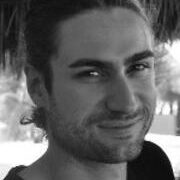 We have been using sensors as an adjunct to medical scanners, to enrich and diversify the information that is being obtained. More specifically, we developed a new type of sensors that use ultrasound fields to probe the anatomy, and called them ‘organ-configuration motion’ (OCM) sensors.
We have been using sensors as an adjunct to medical scanners, to enrich and diversify the information that is being obtained. More specifically, we developed a new type of sensors that use ultrasound fields to probe the anatomy, and called them ‘organ-configuration motion’ (OCM) sensors.
 Our current system is the size of a PC, and up to four OCM sensors can be connected at a time.
Our current system is the size of a PC, and up to four OCM sensors can be connected at a time.
 In our current version, the sensors need to be connected to the system with cables. We are working on a wireless version, which should prove even easier to use, here is an early version.
In our current version, the sensors need to be connected to the system with cables. We are working on a wireless version, which should prove even easier to use, here is an early version.
In terms of applications, we have been using OCM sensors in combination with MRI, and PET. In the example below, MRI images were acquired at a rate of 2 frames per second; at the same time, in parallel, an early version of our sensors was busy gathering ultrasound signals at a much higher temporal rate. When combining MRI and high-rate sensor signals using machine-learning techniques we were able to reconstruct a stream of MRI-like images at a rate of 150 frames per second, a frame rate 75x greater than that of the MRI scanner alone. The video below explains the process and results in more details.
- Madore B, Hess AT, van Niekerk AMJ, Hoinkiss DC, Hucker P, Zaitsev M, Afacan O, Günther M. External hardware and sensors, for improved MRI. J Magn Reson Imaging 2023; 57(3):690-705.
- Madore B, Belsley G, Cheng C-C, Preiswerk P, Foley Kijewski M, Wu P-H, Martell LB, Pluim JPW, Di Carli M, and Moore SC. 12/2022. “Ultrasound-based sensors for respiratory motion assessment in multimodality PET imaging.” Phys Med Biol, 19;67(2).
- Madore B, Preiswerk F, Bredfeldt J, Zong S, and Cheng C-C. 12/2021. “Ultrasound-based sensors to monitor physiological motion.” Med Phys, 48, Pp. 3614-22.
- F Preiswerk, M Toews, C-C Cheng, Jr-y Chiou, C-S Mei, LF Schaefer, W. S. Hoge, B Schwartz, LP Panych, and B Madore. 12/31/2017. “Hybrid MRI ultrasound acquisitions, and scannerless real-time imaging.” Finalist of the YIA Rabi Award, and recipient of a YIA Cum Laude Award. Magn Reson Med, 78, Pp. 897-908.
- Preiswerk F, Toews M, Hoge WS, Chiou J-yG, Panych LP, Wells III WM, Madore B. Hybrid ultrasound and MRI acquisitions for high-speed imaging of respiratory organ motion. In: Navab N, Hornegger J, Wells W, Frangi A, editors. Medical Image Computing and Computer-Assisted Intervention – MICCAI: Springer International Publishing, 2015:315-322.
- Preiswerk F, Cheng C-C, Luo J, Madore B. Synthesizing dynamic MRI using long-term recurrent convolutional networks. Conf. on Machine Learning in Medical Imaging 2018
2022:Oxford, UK. Prospective motion tracking and prospective sequences for body imaging. ISMRM workshop on Motion Detection and Correction.
2021: Virtual meeting. Ultrasound-based sensors to monitor internal motion. AI4US: Unlocking the potential of Artificial Intelligence for Ultrasound image processing. IEEE-EMBS international Conference on Biomedical and Health Informatics, jointly organized with the IEEE International Conference on Wearable and Implantable Body Sensor Network.
2019: Montréal, Québec, Canada. Motion correction with external sensors . Educational session at the 2019 ISMRM meeting.
2019: Boston, MA, USA. Ultrasound-based sensors for enhanced medical imaging performance . World Medical Innovation Forum.
2018: NYU, New York, NY, USA. Hybrid MRI-ultrasound acquisitions . ISMRM-sponsored workshop ‘i2i from innovation to implementation in imaging’.
2018: Boston, MA. Sensors to track the 3D position and orientation of US imaging probes . NCIGT workshop on Image-Guided Therapy.
2018: Proctor Academy in Andover, NH, USA. The instrumented scanner . Gordon Research Conference on In Vivo Magnetic Resonance.
2018: Paris, France. Concurrent MRI: Imaging of real-time events. Educational session at the 2018 ISMRM meeting.
2018: Boston, MA. Ultrasound-based sensors for enhanced MR and PET/CT imaging. Radiology Department, Stony Brook University
2018: Boston, MA. Enhanced MRI using ultrasound-based sensors and machine learning. Brigham Research Institute (BRI) Workshop on Machine Learning.
2017: Boston, MA. Enhanced imaging through the use of sensors in MRI, ultrasound, PET/CT … and radiation oncology? Seminar series, Radiation Oncology, Brigham and Women’s Hospital.
2015: Munich, Germany. Introduction to MRI, course on Intelligent Imaging Linking MR Acquisition and Processing. Annual meeting of the Medical Image Computing and Computer Assisted Interventions (MICCAI) society.
- Willey D, Lynch S, Dickinson O, Truong T-K, Robb F, Song A, Madore B, Darnell D. Motion Monitoring using a Wireless Ultrasound-Based Sensor and an Integrated RF/Wireless Coil Array. In: Proceedings of the International Society of Magnetic Resonance in Medicine. Toronto, Canada; 2023, p. 0753
- Tibrewala R, Keerthivasan M, Bruno M, Collins C, Madore B, Sodickson D. Detecting bladder and pelvic floor motion during MRI using a small ultrasound-based sensor. In: Proceedings of the International Society of Magnetic Resonance in Medicine. Toronto, Canada; 2023, p. 0364.
- Willey D, Dickinson O, Overson D, Truong T-K, Robb F, Song A, Madore B, and Darnell D. “Wireless Physiological Motion Monitoring with an Integrated RF/Wireless Coil Array and MR-Compatible Ultrasound-Based System. Summa Cum Laude Award.” Proceedings of the International Society of Magnetic Resonance in Medicine. London, UK; 2022, p. 3953.
- Madore B, Cheng C-C, and Preiswerk F. “A compact and clonable ultrasound-based sensor system to monitor physiological motion.” Proceedings of the International Society of Magnetic Resonance in Medicine. Virtual Meeting; 2021, p. 4262.
- Willey D, Bresticker J, Truong T-K, Song A, Madore B, and Darnell D. “Integrated RF/Wireless Coil and Ultrasound-Based Sensors to Enable Wireless Physiological Motion Monitoring in MRI.” Proceedings of the International Society of Magnetic Resonance in Medicine. Virtual Meeting; 2020, p. 1282.
- Madore B, Preiswerk F, Bredfeldt J, Zong S, and Cheng C-C. “Motion monitoring using MR-compatible ultrasound-based sensors.” Proceedings of the International Society of Magnetic Resonance in Medicine. Virtual Meeting; 2020, p. 0461.
- Madore B, Cheng C-C, and Preiswerk F. “Combining MR and ultrasound imaging, through sensor-based probe tracking.” Proceedings of the International Society of Magnetic Resonance in Medicine. Montréal, Québec, Canada; 2019, p. 0968
- Kwon J, Cheng C-C, Madore B, Shimizu S, Shirato H, and Bredfeldt J. 2019. “Enabling MRI-guided Radiation Therapy of the Pancreas with MRI Compatible Ultrasound Sensors.” Proceedings of the 61st Annual Meeting of American Association of Physicists in Medicine. San Antonio, USA.
- Madore B, Cheng C-C, and Preiswerk F. “Ultrasound-based sensors for enhanced medical imaging performance.” World Medical Innovation Forum. Boston, MA, USA; 2019.




Associate Professor of Radiology
Bruno obtained a B.Sc. in Physics from Laval University in Québec City, and a Ph.D. in medical biophysics from the University of Toronto. He also performed postdoctoral studies at Stanford University, in fast Magnetic Resonance Imaging (MRI).
His main research expertise lies in the development of novel acquisition and image reconstruction strategies for Magnetic Resonance Imaging. He also has strong interest in ultrasound imaging, and in combining it with MRI. More generally, much of the work in the ALMA lab involves encoding useful information that relates to relaxation, dynamic motion, diffusion and/or thermometry into MR or ultrasound signals in novel ways. This information is then recovered at the image reconstruction stage, to generate images that are better and/or richer in terms of information content than what would otherwise have been the case.
Bruno is Deputy Editor and ‘Senior Deputy Editor for Physics and Techniques’ for the Journal of Magnetic Resonance Imaging (JMRI), one of two official journals of the ISMRM. He was awarded a ‘Distinguished Investigator Award’ by the Academy of Radiology Research in 2016, and a ‘Young Investigators’ Moore Award’ by the ISMRM in 1999.


